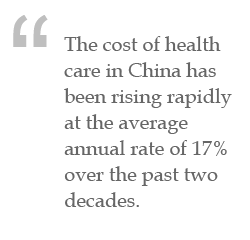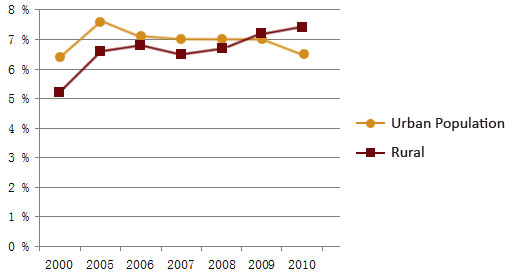In 2009, the Government of China launched its latest round of health system reform, with a significant investment of RMB 850 billion (approximately USD$133 million) in the first three years. Leading up to this reform, since 2003 the government has gradually expanded health insurance coverage by developing new rural cooperative medical schemes and urban resident basic medical insurance. As a result of these new programs, much progress has been made. Over the past decade, the percentage of the Chinese population covered by health insurance has risen rapidly - from less than one- quarter in early 2000s to over 90% in 2010. Furthermore, access to and use of health services by the Chinese population has increased significantly.
Out-of-pocket payments as a percentage of total health expenditure have reduced from over 55% in the early 2000s to only 38% in 2010. This result is attributed to a rapid increase in government health and social health expenditures since 2003. These achievements have been widely reported in Chinese media and academic journals in China and internationally. However, I have been wondering, is this significant amount of government investment actually improving the affordability for health care, particularly for the poor and vulnerable? This is a critical question the Chinese policy-makers have to answer using sound empirical evidence.
What the Data Tells Us
With the assistance of several Chinese health system researchers, I have reviewed the data emanating from the national health account studies, and the recently published China Statistical Yearbook and China Population Statistical Yearbook. To my surprise, what I found is that while the share of out-of-pocket payment in total health expenditures declined in recent years, as a percentage of annual household consumption, out-of-pocket payments have continued to rise.
For the rural population, this amount has risen from 5.2% in 2000 to 7.4% in 2010. People from less developed regions of China, not least developed nor most developed ones, had the highest proportion of health service expenses paid for out-of-pocket, often exceeding 10%, a threshold for catastrophic expenditure defined by WHO. This is due largely to the fact that the least developed regions (often in the Western part of China) have received more government health investment, while the less-developed regions (often located in central China) have neither received huge financial subsidies nor did the local government have enough funds to increase funding for health. Despite Investment, Progress is Lagging
So, why has such a huge increase of public health care spending in China not yet improved the affordability for health services, particularly in the rural areas? There are a number of reasons.
- First, the health insurance schemes, particularly for the rural and urban residents (not the one for urban employees), do not offer adequate financial protection for the insured. The service benefit packages offered by most of these schemes had not covered outpatient services. Even those schemes that do cover some outpatient services, the percentages of reimbursement were often very low level (e.g. 20-30%). For example, a person being treated for diabetes but does not require hospitalization often will not receive any financial support from the rural health insurance schemes.
- There has been a rapid increase of health care costs, due partly to pervert financial incentives given to service providers to generate revenues, part of which can be used to increase the income of doctors and nurses. The cost of health care in China has been rising rapidly at the average annual rate of 17% over the past two decades, much faster than the rate of GDP growth.
- While the annual household income and consumption expenditure per capita among the urban population has increased reasonably in line of GDP growth (around 13-14% in 2000-2009), the increase in annual household consumption expenditure per capita in the rural population has been much slower, around 10%.
It is unfortunate that the rapid increase of public funding to support health care in rural China, as part of the health system reform strategy, has not mitigated the out-of-pocket payments for the rural population. There is an urgent need to improve the design of the Chinese health insurance schemes to better control cost escalation of health care and offer better service benefit packages to the rural and vulnerable. New injection of government funding should ensure the reduction of financial burden on the people, improving the affordability of quality care, and achieving better health outcomes. That is what the new health system reform in China is aimed for. Out-of-pocket payment per capita as a percentage of average annual household consumption expenditure per capita (%) for the urban and rural population in 2000-2010





